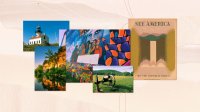3 Ways the National Park Service Can Support PBL
Teachers can access a variety of resources from the National Park Service to set up engaging project-based learning units.
Your content has been saved!
Go to My Saved Content.While many teachers are aware of the benefits of high-quality project-based learning (PBL), delivering those experiences to students isn’t always easy. Teachers are often especially concerned with challenges like authenticity, honoring individual students, and elevating student work outside the classroom. I’ve seen these challenges, inherent in the facilitation of real-world learning, come up time and time again and trip up even the most dedicated teachers.
During the summer, I work as a facilitator for the National Park Service (NPS) Teacher Ranger Teacher Program, a professional development program where classroom teachers work in parks across the country and create learning resources for the parks that they can then bring back to their classrooms. My work over the past two years has brought me into contact with educators from throughout the United States and its territories. In the process, I’ve been introduced to examples of collaborations between schools and parks that provide solutions to some common PBL problems. Here are three examples of the power of collaborations between classroom educators and national parks.
1. Use Classroom Projects to Connect Students to Their Community
If what students learn has little perceived relevance to the world directly outside the classroom, projects suffer. Not only does that cut into the authenticity of a project, but in subjects like history—where the content can focus on places and events that don’t reflect the culture of the students in your classroom—it can send the subtle message that they and their lived experience aren’t significant. Connecting learning back to a student’s own community counteracts this notion and contributes positively to skills like mathematical thinking and reading comprehension.
The Buffalo National River in northern Arkansas, the first waterway designated a national river, is home to hundreds of years of human history and thousands of stories. To support the efforts of the NPS to interpret the history of the region, students from Harrison Middle School created a video about one of the last residents of the area, Granny Henderson, by visiting her homesite and interviewing her descendants. This project not only helped develop key history and literacy competencies but also connected students to a story that had cultural parallels to their own.
2. Maintain Individual Voice in a Group Project
Large-scale products, such as school gardens or collaborative murals, are advantageous for several reasons: They save the teacher from having to manage and monitor multiple final products, and they leverage the collective effort of an entire classroom. However, the tradeoff is that you have to coalesce around a singular plan, meaning lots of compromise and the loss of individual student voice.
In 2018, a group of Topeka, Kansas, artists worked with the National Historical Parks to create a community mural commemorating the Supreme Court’s decision in the case Brown v. Board of Education, which outlawed school segregation. Lots of community members, including a large contingent of students, contributed to the effort. To ensure that individual voices and creativity were honored in the process, each collaborator was given a small section at the bottom of the mural to make their own.
Setting aside space or creating an element that affirms individual ideas and contributions that weren’t incorporated into the main product helps ensure that all students see the value of their learning and view themselves in the final product.
3. Wide Visibility ensures That Students know their WORK is Impactful
A core component of PBL is showing students that their knowledge and expertise matters by making sure that their work is destined for somewhere other than the teacher’s filing cabinet. The culmination of their hard-won knowledge and skills should have an impact. If it doesn’t, this significantly detracts from the impact that a project can have.
An example of this is writing a letter to an elected representative. While writing a formal letter like this is a great way to develop literacy and knowledge of civics, when the representative doesn’t reply (and they probably won’t), what message are the students getting about the value of the work if it has no observable impact?
Guaranteeing students a wider audience for their work means displaying it in a place where the people seeing it are interested in the content being shared. National park visitor centers are a perfect location for this. Lots of people stop by, and those who do are already expecting to engage with learning opportunities in the form of exhibits or displays.
Students from High Tech Middle School in San Diego displayed their research projects on local area animal species in the visitor center at Cabrillo National Monument, which meant they would get lots of interested viewers. Passive viewing is fine, but finding ways to encourage audience interaction is better. A collection of student photo essays at Kennesaw Mountain National Battlefield Park included reflective questions for the audience to answer, along with a social media hashtag that the students could monitor to see the impact their work was having.
If you would like to learn more about how resources from the National Park Service might support PBL in your classroom, you’re in luck. Their education portal is a great place to start and provides information for all grade levels. You might also consider joining an online community of educators who are passionate about integrating parks into their practice.
